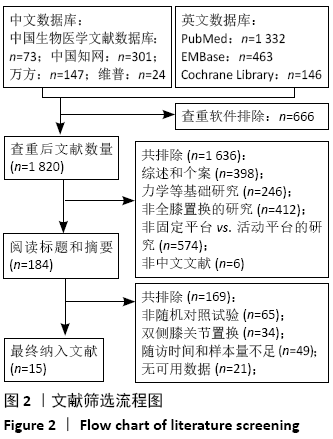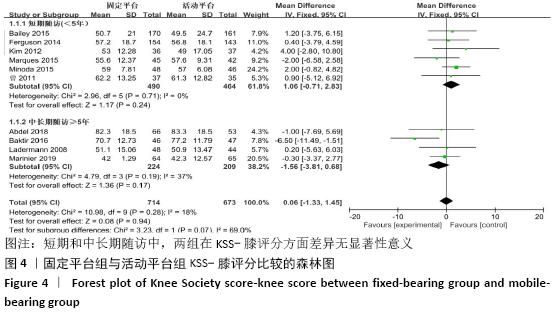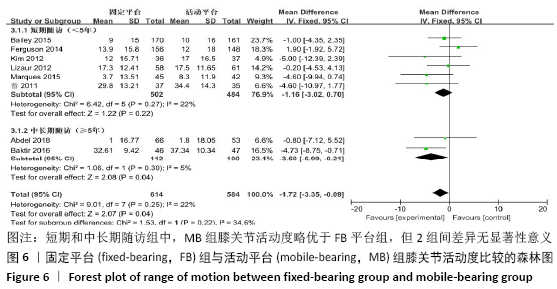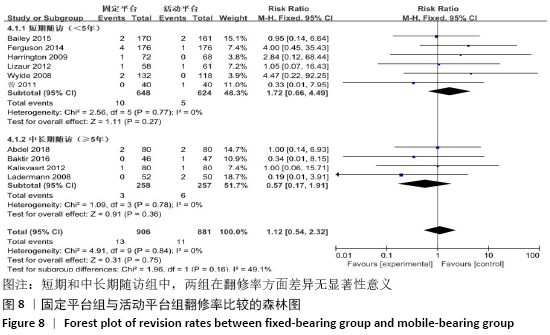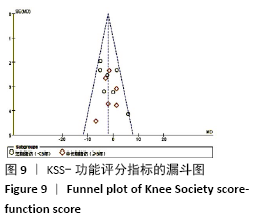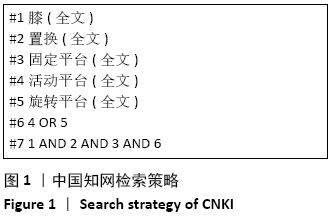[1] AGLIETTI P, BALDINI A, BUZZI R, et al. Comparison of mobile-bearing and fixed-bearing total knee arthroplasty: a prospective randomized study. J Arthroplasty. 2005;20(2):145-153.
[2] HAIDER H, GARVIN K. Rotating platform versus fixed-bearing total knees: an in vitro study of wear. Clin Orthop Relat Res. 2008;466(11):2677-2685.
[3] HO FY, MA HM, LIAU JJ, et al. Mobile-bearing knees reduce rotational asymmetric wear. Clin Orthop Relat Res. 2007;462:143-149.
[4] LI YL, WU Q, NING GZ, et al. No difference in clinical outcome between fixed- and mobile-bearing TKA: a meta-analysis. Knee Surg Sports Traumatol Arthrosc. 2014;22(3):565-575.
[5] MOSKAL JT, CAPPS SG. Rotating-platform TKA no different from fixed-bearing TKA regarding survivorship or performance: a meta-analysis. Clin Orthop Relat Res. 2014;472(7):2185-2193.
[6] BO ZD, LIAO L, ZHAO JM, et al. Mobile bearing or fixed bearing? A meta-analysis of outcomes comparing mobile bearing and fixed bearing bilateral total knee replacements. Knee. 2014;21(2):374-381.
[7] 曹力,龚时国,康雄,等.活动平台与固定平台假体全膝关节置换术疗效的Meta分析[J]. 中华骨科杂志,2009,29(2):97-102.
[8] SHEMSHAKI H, DEHGHANI M, ESHAGHI MA, et al. Fixed versus mobile weight-bearing prosthesis in total knee arthroplasty. Knee Surg Sports Traumatol Arthrosc. 2012;20(12):2519-2527.
[9] SAPPEY-MARINIER E, DE ABREU FGA, O’LOUGHLIN P, et al. No difference in patellar position between mobile-bearing and fixed-bearing total knee arthroplasty for medial osteoarthritis: a prospective randomized study. Knee Surg Sports Traumatol Arthrosc. 2020;28(5):1542-1550.
[10] MARQUES CJ, DANIEL S, SUFI-SIAVACH A, et al. No differences in clinical outcomes between fixed- and mobile-bearing computer-assisted total knee arthroplasties and no correlations between navigation data and clinical scores. Knee Surg Sports Traumatol Arthrosc. 2015;23(6):1660-1668.
[11] LIZAUR-UTRILLA A, SANZ-REIG J, TRIGUEROS-RENTERO MA. Greater satisfaction in older patients with a mobile-bearing compared with fixed-bearing total knee arthroplasty. J Arthroplasty. 2012;27(2):207-212.
[12] LADERMANN A, LÜBBEKE A, STERN R, et al. Fixed-bearing versus mobile-bearing total knee arthroplasty: a prospective randomised, clinical and radiological study with mid-term results at 7 years. Knee. 2008;15(3):206-210.
[13] KIM D, SEONG SC, LEE MC, et al. Comparison of the tibiofemoral rotational alignment after mobile and fixed bearing total knee arthroplasty. Knee Surg Sports Traumatol Arthrosc. 2012;20(2):337-345.
[14] HARRINGTON MA, HOPKINSON WJ, HSU P, et al. Fixed- vs mobile-bearing total knee arthroplasty: does it make a difference? A prospective randomized study. J Arthroplasty. 2009;24(6 Suppl):24-27.
[15] FERGUSON KB, BAILEY O, ANTHONY I, et al. A prospective randomised study comparing rotating platform and fixed bearing total knee arthroplasty in a cruciate substituting design-outcomes at two year follow-up. Knee. 2014;21(1):151-155.
[16] BAKTIR A, KARAASLAN F, YURDAKUL E, et al. Mobile- versus fixed-bearing total knee arthroplasty: a prospective randomized controlled trial featuring 6-10-year follow-up. Acta Orthop Traumatol Turc. 2016;50(1):1-9.
[17] BAILEY O, FERGUSON K, CRAWFURD E, et al. No clinical difference between fixed- and mobile-bearing cruciate-retaining total knee arthroplasty: a prospective randomized study. Knee Surg Sports Traumatol Arthrosc. 2015;23(6):1653-1659.
[18] 曾赟,曹力,刘阳,等.固定平台型和旋转平台型假体全膝关节置换术后早期疗效的随机对照研究[J].中华医学杂志, 2011,91(11):752-756.
[19] WYLDE V, LEARMONTH I, POTTER A, et al. Patient-reported outcomes after fixed-versus mobile-bearing total knee replacement: a multi-centre randomised controlled trial using the Kinemax total knee replacement. J Bone Joint Surg Br. 2008;90(9):1172-1179.
[20] MINODA Y, IWAKI H, IKEBUCHI M, et al. Mobile-bearing prosthesis and intraoperative gap balancing are not predictors of superior knee flexion: a prospective randomized study. Knee Surg Sports Traumatol Arthrosc. 2015;23(7):1986-1992.
[21] KALISVAART MM, PAGNANO MW, TROUSDALE RT, et al. Randomized clinical trial of rotating-platform and fixed-bearing total knee arthroplasty: no clinically detectable differences at five years. J Bone Joint Surg Am. 2012;94(6):481-489.
[22] ABDEL MP, TIBBO ME, STUART MJ, et al. A randomized controlled trial of fixed- versus mobile-bearing total knee arthroplasty: a follow-up at a mean of ten years. Bone Joint J. 2018; 100-B(7):925-929.
[23] MCEWEN HM, BARNETT PI, BELL CJ, et al. The influence of design, materials and kinematics on the in vitro wear of total knee replacements. J Biomech. 2005;38(2):357-365.
[24] HASEGAWA M, SUDO A, UCHIDA A. Staged bilateral mobile-bearing and fixed-bearing total knee arthroplasty in the same patients: a prospective comparison of a posterior-stabilized prosthesis. Knee Surg Sports Traumatol Arthrosc. 2009;17(3):237-243.
[25] HUANG CH, LIAU JJ, CHENG CK. Fixed or mobile-bearing total knee arthroplasty. J Orthop Surg Res. 2007;2:1.
[26] MATSUDA S, MIZU-UCHI H, FUKAGAWA S, et al. Mobile-bearing prosthesis did not improve mid-term clinical results of total knee arthroplasty. Knee Surg Sports Traumatol Arthrosc. 2010;18(10): 1311-1316.
[27] HIGUCHI H, HATAYAMA K, SHIMIZU M, et al. Relationship between joint gap difference and range of motion in total knee arthroplasty: a prospective randomised study between different platforms. Int Orthop. 2009;33(4):997-1000.
[28] BHAN S, MALHOTRA R, KIRAN EK, et al. A comparison of fixed-bearing and mobile-bearing total knee arthroplasty at a minimum follow-up of 4.5 years. J Bone Joint Surg Am. 2005;87(10): 2290-2296.
[29] OH KJ, PANDHER DS, LEE SH, et al. Meta-analysis comparing outcomes of fixed-bearing and mobile-bearing prostheses in total knee arthroplasty. J Arthroplasty. 2009;24(6):873-884.
[30] SMITH TO, EJTEHADI F, NICHOLS R, et al. Clinical and radiological outcomes of fixed-versus mobile-bearing total knee replacement: a meta-analysis. Knee Surg Sports Traumatol Arthrosc. 2010;18(3):325-340.
[31] 韩俊亮,段王平,高耀祖,等.移动平台型假体与固定平台型假体全膝置换术治疗膝关节炎疗效的Meta分析[J].中华关节外科杂志(电子版), 2015,9(3):370-376.
|

